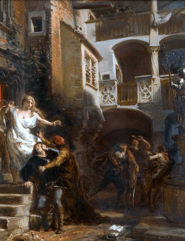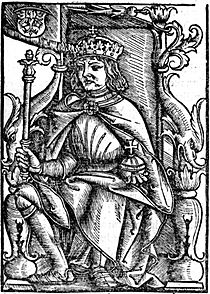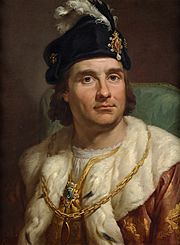John I Albert facts for kids
Quick facts for kids John I Albert |
|
|---|---|
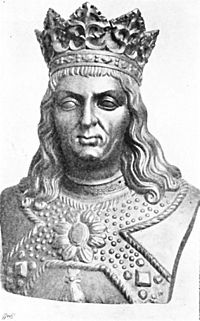
John Albert's tomb effigy at Wawel Cathedral
|
|
| King of Poland | |
| Reign | 27 August 1492 – 17 June 1501 |
| Coronation | 23 September 1492 |
| Predecessor | Casimir IV |
| Successor | Alexander I |
| Born | 27 December 1459 Kraków, Kingdom of Poland |
| Died | 17 June 1501 (aged 41) Toruń, Kingdom of Poland |
| Burial | July 1501 Wawel Cathedral, Kraków |
| Dynasty | Jagiellon |
| Father | Casimir IV of Poland |
| Mother | Elizabeth of Austria |
| Religion | Roman Catholic |
John I Albert (Polish: Jan I Olbracht; 27 December 1459 – 17 June 1501) was the King of Poland from 1492 until his death. He was also the Duke of Głogów from 1491 to 1498. John Albert was the fourth Polish ruler from the Jagiellonian dynasty. His parents were Casimir IV and Elizabeth of Austria.
John Albert was a well-educated prince. He had famous teachers like Johannes Longinus and Callimachus. He was inspired by the Italian Renaissance and wanted to make the king's power stronger. In 1487, he led an army against the Ottoman Empire. He defeated the Tatars from the Crimean Khanate during an early war between Poland and the Ottomans. He later became the Duke of Głogów to satisfy his ambitions.
John became King of Poland in 1492. His younger brother, Alexander, became the Grand Duke of Lithuania. This meant Poland and Lithuania were separate for a while. John Albert tried to make his rule stronger by sending an army to the election. This upset some powerful nobles. He also invaded Masovia to gain more control. In 1497, John Albert led a military campaign into Moldavia. He wanted to show Poland's power and control ports on the Black Sea. This campaign failed and stopped Poland from expanding further into Southeastern Europe.
John Albert's reign was quite short and ended with a big military defeat. He was sometimes criticized for wanting to have absolute power as king. However, he is remembered for creating a parliament with two parts: the Senate and the Sejm. This gave lower-class nobles a voice in how the country was run. On the other hand, he also limited the freedom of peasants, making them stay on nobles' lands for life.
Contents
Early Life and Education
Birth and Royal Family
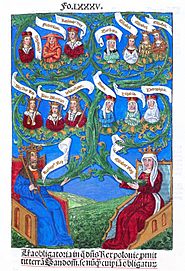
John was born on December 27, 1459, in Kraków. He was born at Wawel Castle, which was where Polish kings lived. He was one of thirteen children. He was the third son of Casimir IV Jagiellon and Elizabeth Habsburg. His mother was related to the House of Habsburg.
John's parents hoped one of their sons would become the Emperor of the Holy Roman Empire. So, John was given the middle name Albert to honor his grandfather. This was also to help his chances of becoming emperor.
John's grandfather was Jogaila, a pagan ruler of Lithuania. Jogaila became Catholic and was crowned King of Poland in 1386. His descendants, the Jagiellonians, had a strong claim to rule Lithuania. After Jogaila's death, his eldest son, Ladislaus III, became King of Poland. His younger son, Casimir, became Grand Duke of Lithuania. When Ladislaus died in battle in 1444, Casimir's sons could become rulers of both.
John's oldest brother, Vladislaus, was supposed to inherit Poland and Lithuania. But Vladislaus became King of Bohemia in 1471. Then, John's second brother, Casimir, became the next in line for the Polish throne. However, Casimir died in 1484 from tuberculosis. Six years later, Vladislaus became King of Hungary. Some Hungarian nobles wanted John Albert to be king instead. John briefly tried to take over Hungary but was defeated by his brother. Despite this, they remained close. Vladislaus made John the Duke of Głogów for life.
Learning and Mentors
King Casimir IV wanted all his sons to be well-educated. He wanted them to be ready to become kings. In 1467, a historian named Johannes Longinus became their teacher. Longinus was a very religious man. He made sure the princes were raised according to Church rules. John and his brother Alexander were taught to visit the tombs of past kings. This was to make them feel loyal to Poland.
Their lessons included Latin and German, law, history, and public speaking. They also studied classic books. Another important teacher was Filippo Buonaccorsi, also known as Callimachus. He was an Italian scholar and diplomat. Callimachus had a big influence on John. He was more relaxed than Longinus. He added chess, sports, and ancient studies to their lessons.
Callimachus had some new ideas for the time. He believed the king should have more power. He also thought the power of the clergy (church leaders) should be limited. John liked many of these ideas. Callimachus became John's trusted friend and advisor.
John Albert's Reign: 1492–1501
Becoming King in 1492
When King Casimir IV died, he wanted John to be King of Poland. He wanted his brother Alexander to be Grand Duke of Lithuania. The Lithuanian nobles agreed. But some Polish nobles wanted to keep Poland and Lithuania united under one ruler. They first wanted Alexander to be king.
An election meeting was held in Piotrków on August 15, 1492. The nobles had to choose the next king. John's victory against the Tatars in 1487 helped his chances. But some nobles thought he was too proud. Some powerful families supported John's younger brother, Sigismund.
There were many arguments among the powerful state members. Two dukes from Masovia, Janusz II and Konrad III, arrived with 1,000 soldiers. They wanted to bring back the old Piast family to the Polish throne. The Queen Mother, Elizabeth, chose her son, Cardinal Frederick Jagiellon, to lead the election.
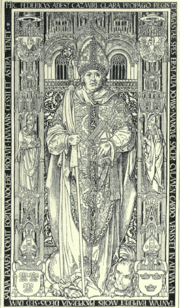
An army of 1,600 men was sent to stop the Masovian dukes if they caused trouble. John also tried to get votes from Prussia. In the end, Cardinal Frederick helped John win the crown. John was declared king on August 27, 1492. The people of Kraków were very happy and celebrated. He was crowned at Wawel Cathedral on September 23.
John Albert's first months as king were difficult. The Masovian dukes were still a threat. In December 1492, John made an alliance with his brother Vladislaus, King of Hungary. They promised to help each other against their enemies.
Creating a Parliament
Poland had a history of nobles gaining rights from the king. In 1374, King Louis I gave nobles tax breaks for their support. Earlier attempts to unite lower-class nobles with powerful magnates did not work well. Lower-class nobles were unhappy with how justice was handled by the upper class. A big step forward happened in 1454. John's father, Casimir, agreed that the king had to ask for advice from nobles before making decisions. This helped create an early parliamentary system.
Before John Albert, the king had a council called the curia regis. This council had no real power over the king. Its members were trusted advisors chosen by the king. Under John Albert, this council slowly became the Senate of Poland. King Casimir IV used to travel to different regional meetings of nobles. But John Albert called representatives from all over the country to one meeting. This created a single, unified assembly.
In January 1493, the first parliament with two chambers met in Piotrków. This city would host parliament meetings for a long time. The parliament officially started on January 18. The king issued a law about taxes on March 2 and closed the meeting on March 3.
Jews Expelled from Kraków
In June 1494, a fire started in Kraków. It happened while a Turkish diplomat was visiting. The fire spread and burned the Church of Saint Mark and nearby homes. People panicked and blamed the Jews for the fire. Jewish businesses and homes were robbed. Riots against the Jewish community followed.
Jewish residents and city officials complained to John Albert. John at first put Jewish leaders in prison. But his advisor Callimachus convinced him to release them. In 1495, John ordered Jews to leave Kraków. They were moved to the nearby town of Kazimierz. This town became an important center for Judaism in Poland. Some historians suggest the move was partly voluntary. It was to protect the Jews from persecution by Christians.
Taking Control of Masovia
John Albert wanted to make the king's power stronger over all of Poland's lands. This included the Duchy of Masovia. Its rulers were related to the Lithuanian royal family. The Jagiellonian kings saw Masovia as a separate state that challenged their full power. John wanted to make Masovia more like Poland.
When Duke Janusz II died in February 1495 without children, his brother Konrad tried to secure his claim to the throne. He sent troops to protect Masovian castles. But John quickly gathered a small army. He marched into Masovia and took control of the city of Płock. This was an important religious center. Cardinal Frederick then made sure a Polish bishop was in charge there. Konrad ordered his men to stop fighting. This allowed the Jagiellons to claim Masovia. A year later, Konrad had to show respect to John. He lost most of his lands and family possessions because he was accused of not obeying the king.
Moldavian Campaign of 1497
John wanted to be seen as a protector of Christianity against the Ottoman Turks. He also wanted to get back ports near the Black Sea and strengthen Poland's power over Moldavia. His main goal was to put his younger brother, Sigismund, on the Moldavian throne.
In May 1496, John raised taxes to pay for the upcoming war. He told people the war was to defend Poland from the Ottomans. He did not mention his real goal of changing the ruler of Moldavia. In August 1497, the Church also had to pay 25 percent of its income to support the king. By the summer of 1497, John had a large army of about 80,000 men with heavy cannons. The ruler of Moldavia, Stephen III, tried to stop the Poles. He also convinced John's brother Alexander not to join the campaign. Lithuanian nobles also refused to enter Moldavia.
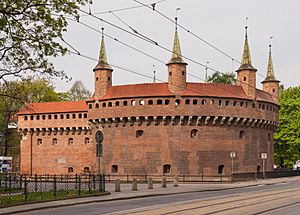
The Polish army marched into Moldavia in August 1497. The Ottoman Sultan sent about 600 soldiers to help Stephen. Stephen tried to make peace, but John refused. The Polish army tried to attack Suceava but failed. The siege lasted from September 24 to October 19. The Polish army's supplies were cut off, and soldiers got sick. John himself became ill. The siege ended when John's brother Vladislaus sent a Hungarian army to help Stephen.
A truce was signed. As the Polish army retreated, the Moldavians attacked them in the Battle of the Cosmin Forest. The Polish heavy cavalry could not fight well in the thick woods. This attack caused many deaths and a loss of honor for the Polish army. John finally agreed to a peace treaty in 1499. He had to accept Stephen as an equal ruler, not as someone under Polish control.
This defeat led to raids on Polish land by Tatars and other groups. In July 1498, Turkish raiders attacked Podolia and reached as far as Lwów. Fearing more attacks, John ordered new defenses to be built. This included the Kraków Barbican, a famous monument in Poland.
Conflict with Teutonic Knights
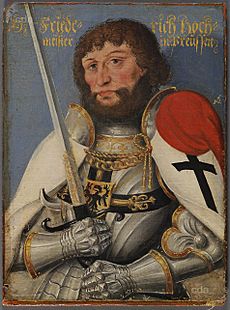
After a war, Prussia became a royal dependency of Poland. This caused tension between the Teutonic Order and the Polish Crown. The tension grew when John tried to make his brother Frederick the new bishop in Warmia.
When the Grand Master of the Teutonic Order died, Friedrich Wettin von Sachsen became the new Grand Master. Unlike the previous one, Friedrich refused to show loyalty to the Polish Crown. He did not follow the peace treaty signed in 1466. In 1499, he refused to attend a parliament meeting in Poland. He said he had problems at home. He took the issue to the Holy Roman Empire's parliament. The Emperor, Maximilian I, allowed Friedrich to help Poland if needed. But he said Friedrich should not swear loyalty to the Polish king.
John demanded five times that the Teutonic Knights show respect and obedience. When Emperor Maximilian said the peace treaty was not valid, John gathered an army. He went to Toruń in 1501, where the treaty was first signed. Friedrich refused to meet John but sent representatives to talk. A duke named George, who was John's brother-in-law, tried to help make peace. But the talks stopped when John died suddenly.
Death and Burial
The difficult Moldavian campaign likely affected John's health. He died suddenly on June 17, 1501, in Toruń. He was there to negotiate with the Teutonic Knights. His body was prepared for the journey back to Kraków. On June 29, his funeral procession left Toruń. His heart was buried inside the Toruń Cathedral, but its exact spot is unknown.
John was buried on July 28, 1501, at Wawel Cathedral in Kraków. His tomb is in one of the chapels next to the main part of the cathedral. The red-marble tombstone shows the king's image. It was made by Stanisław Stwosz. From 1502 to 1505, an artist named Francesco Fiorentino created a beautiful Renaissance archway for the tomb. This tomb is seen as the first Renaissance artwork in Poland. It was a big step forward in Polish architecture.
Personal Life and Legacy
Unlike his brother Alexander, John had strong opinions and was not easily swayed. Some historians called him a "brave soldier, but not a great commander." He was very interested in military matters and wanted the king to have absolute power. This came from his education with Callimachus.
To get support for the Moldavian Campaign, John had to please the nobles. In 1496, he made a law that townspeople could not own land. He also took away the freedom of movement for peasants. This meant peasants had to stay on the nobles' estates, called folwarks, for life. This helped the nobles but slowed down the growth of Polish towns and cities.
John never married. He was known to be intelligent and good at languages. This helped him in diplomacy. In his private life, he enjoyed feasting and hunting.
A writer named Miechowita described John as "tall, brown-eyed, with reddish skin on the face... he was quick in movement and wore a smallsword."
John had a very large royal court. It was the biggest of any Polish king, with about 1,600 knights and courtiers.
See also
 In Spanish: Juan I Alberto de Polonia para niños
In Spanish: Juan I Alberto de Polonia para niños
- History of Poland (1385–1569)
- Piotrków Statutes


